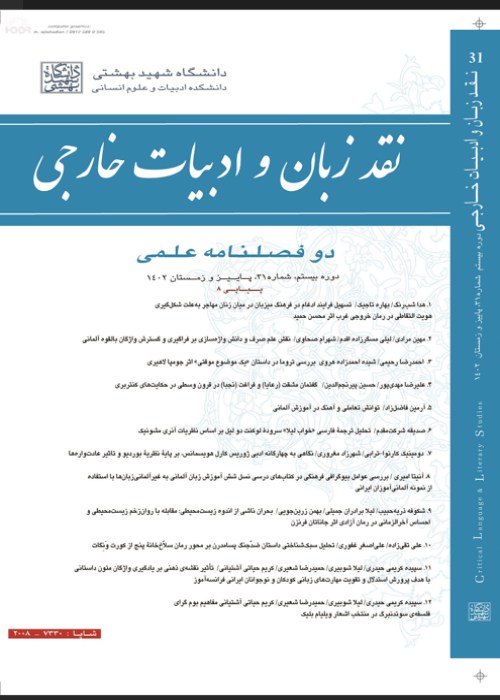An ‘Intra’textual Reading of David Mitchell’s Cloud Atlas
Author(s):
Article Type:
Research/Original Article (دارای رتبه معتبر)
Abstract:
Introduction
Like intertextuality, intratextuality is an important notion in textual analysis and narratological studies. It does not deny functional and conceptual similarities with intertextuality, which is a more familiar narratological term. While intertextuality seeks interconnectedness among hypertexts and hypotexts, intratextuality sets about to discover and decipher it within the structural totality of a single work. In other words, the emphasis is laid on self-reflexivity rather than other-reflexivity in that the objective is to unveil the connectivity that in-text narratives, sub-narratives and frame stories maintain through sustained allusions and dialogues. The major questions of the research include: What is intratextuality and what are its characteristic features? Are they discernible in the narrative fabric of David Mitchell’s Cloud Atlas? What structural and thematic roles, if any, do they play? Background Studies: Bakhtine’s Dostoevsky's Poetics (1929), Kristeva’s Desire in Language: A Semiotic Approach to Literature and Art (1969), Barthes’ Image-Music-Text (1977), and Genette’s Palimpsests: Literature in the Second Degree (1982) are among important sources on intertextuality and its principal categorisations. In his article "Moonlight Bright as a UFO Abduction: Science Fiction, Present-Future Alienation and Cognitive Mapping" (2011), William Stephenson claims that Michell’s sci-fi novel is highly polyphonic and multifaceted. In his article, “Speculative Fiction as Postcolonial Critique in Ghostwritten and Cloud Atlas,” Nicholas Dunlop argues that Mitchell’s postmodern novel harmoniously mixes different and heterogeneous narrative styles as well as typical aspects of sci-fi and fantasy novels. George Gessert’s 2005 article, “Cloud Atlas by David Mitchell,” predominantly deals with plot-development, characterisation, and story-telling techniques, beside such themes as inhumanity, slavery, and apocalypse. In Close Reading with Computers: Textual Scholarship, Computational Formalism, and David Mitchell’s Cloud Atlas (2020), Martin Paul Eve uses computer-assisted charts to analyse lexical and grammatical distributions in the novel to prove the unity and harmony of narrativity despite all apparent heterogeneities.Materials and Methods
To answer the stated questions, this narratological study first offers a brief digest of the term intratextuality, which recognises and endeavours to locate intertextual relations and echoes inside the narrative structure of the same work, and then probes its applicability to the Mitchell’s Cloud Atlas. Genette’s well-known hypertext and hypotext as well as his five-partite categorisation of transtextuality, comprising intertextuality, metatextuality, paratextuality, hypotextuality, and archetextuality are also contextualised in the novel. In addition, notions such as organic narration, self-reflexivity, self-allusiveness, symmetricality, and in-text relations are deemed pivotal throughout the mainstream discussionsResults and Discussion
This research shows that identical characters and incidents, one way or another, keep reappearing in all of the six nested stories of the novel, thereby constructing a tightly-knit network of reciprocal references and allusions within its narrative structure. Furthermore, the sustained recurrence of such motifs as reincarnation, dominance, quest for truth, death and symbols and images associated with them in all narratives creates an intratextuality of self-reflexive themes, which reaffirm themselves in every new intratextual dialogue. Transtextual relations are also discernible in the novel, predominantly in the repeated titles of the six narratives in two halves of the novel, protagonists’ comments on characters and incidents in a previous narrative, and in recurring themes and motifs which expand and modify in every new appearance.Keywords:
Language:
Persian
Published:
Critical Language & Literary Studies, Volume:19 Issue: 28, 2022
Pages:
219 to 246
magiran.com/p2480804
دانلود و مطالعه متن این مقاله با یکی از روشهای زیر امکان پذیر است:
اشتراک شخصی
با عضویت و پرداخت آنلاین حق اشتراک یکساله به مبلغ 1,390,000ريال میتوانید 70 عنوان مطلب دانلود کنید!
اشتراک سازمانی
به کتابخانه دانشگاه یا محل کار خود پیشنهاد کنید تا اشتراک سازمانی این پایگاه را برای دسترسی نامحدود همه کاربران به متن مطالب تهیه نمایند!
توجه!
- حق عضویت دریافتی صرف حمایت از نشریات عضو و نگهداری، تکمیل و توسعه مگیران میشود.
- پرداخت حق اشتراک و دانلود مقالات اجازه بازنشر آن در سایر رسانههای چاپی و دیجیتال را به کاربر نمیدهد.
In order to view content subscription is required
Personal subscription
Subscribe magiran.com for 70 € euros via PayPal and download 70 articles during a year.
Organization subscription
Please contact us to subscribe your university or library for unlimited access!


